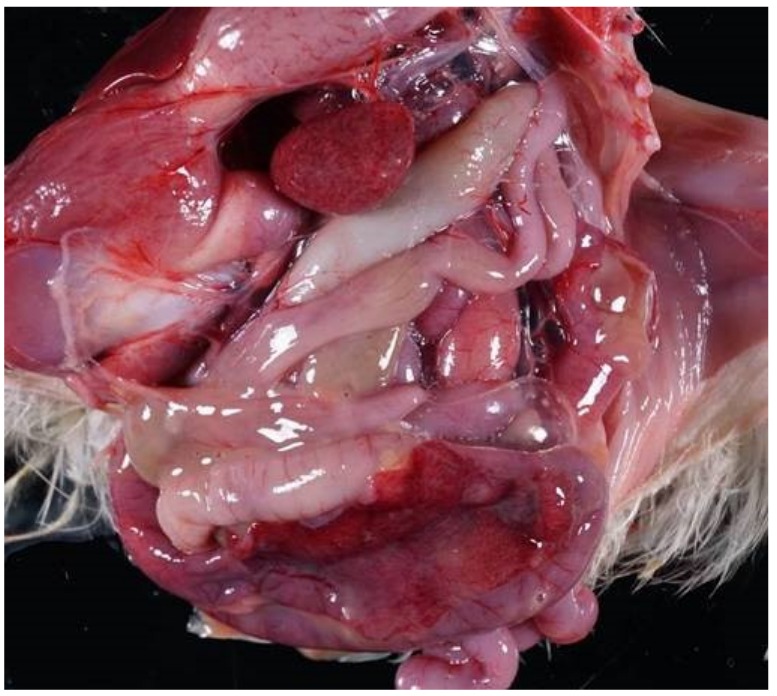Streptococcosis in Poultry
By
, DVM, PhD, DACPV, College of Veterinary Medicine, Western University of Health Sciences
Last full review/revision May 2019

Streptococcosis is caused by bacteria that are part of the normal flora of the intestinal tract, so infections are often thought to occur secondarily to other diseases. It has been reported in numerous bird species throughout the world. There are two forms of the disease, an acute septicemic form and a chronic form. Flock mortality can be as high as 50%. Diagnosis is confirmed with isolation of the organism via culture. Treatment has been effective for early acute infections, with efficacy decreasing as the disease becomes chronic.
Etiology and Epidemiology of Streptococcosis in Poultry
Streptococci are nonmotile, gram-positive, catalase-negative coccoid bacteria that occur singly, in pairs, or in short chains when observed on stained smears. The genetic diversity of Streptococcus spp is expansive and multiple species have been reclassified to the closely related genus Enterococcus or their nomenclature has been updated. Streptococcus spp associated with disease in avian species include:
-
S equi zooepidemicus (S gallinarum)
-
S gallolyticus (formerly S bovis)
-
S dysgalactiae
-
S gallinaceus
-
S mutans
Streptococci have been associated with:
-
acute septicemia
-
joint infections
-
cellulitis
-
osteomyelitis
-
endocarditis
Transmission is via oral or aerosol routes as well as through skin injuries.
Clinical Findings of Streptococcosis in Poultry
Streptococcal infections can be localized or septicemic. Endocarditis and lameness occur during the subacute or chronic stage of the infection. In S equi zooepidemicus infections, clinical signs are typical of an acute septicemic infection, and lethargic birds are often prostrate. In affected layers, egg production may drop by 15%. In pigeons, S gallolyticus infection produces acute mortality with lameness, inappetence, diarrhea, and the inability to fly. Acute fibrinopurulent conjunctivitis has been noted in infections caused by other
Lesions in the acute septicemic form of streptococcosis include:
-
splenomegaly
-
hepatomegaly (with or without reddish tan to white multifocal necrotic foci)
-
enlarged kidneys There may also be serosanguineous fluid in the subcutaneous space and in the pericardium. Bloodstained feathers around the mouth and head due to blood from the oral cavity have been reported occasionally. Cellulitis involving the skin and subcutaneous tissues has been associated with both Escherichia coli and S dysgalactiae. Chronic streptococcal infections result in:
-
arthritis and/or tenosynovitis
-
osteomyelitis
-
salpingitis
-
pericarditis
-
myocarditis
-
valvular endocarditis
Lesions on the heart valves appear as small, yellowish-white or tan, raised areas on the valvular surface. Focal granulomas, as a result of septic emboli, can be found in many tissues. Gram-positive bacterial colonies are readily observed in thrombosed vessels and within necrotic foci microscopically.
Diagnosis of Streptococcosis in Poultry
-
Blood culture from lesion sample
History, clinical signs, and lesions, along with demonstration of Streptococcus-like bacteria in blood films or impression smears of affected tissues, allows for a presumptive diagnosis of streptococcosis. Isolation of Streptococcus spp from lesions confirms the diagnosis. Streptococci can be cultured easily on blood agar.
Differential diagnoses of streptococcosis include other bacterial septicemic diseases, including:
-
staphylococcosis
-
enterococcosis
-
colibacillosis
-
pasteurellosis
-
erysipelas
and when blood is noted coming from the mouth:
-
infectious laryngotracheitis
-
pasteurellosis
-
avian influenza
-
exotic Newcastle disease
Treatment and Control of Streptococcosis in Poultry
-
Antibiotics
-
Prevention of immunosuppressive diseases/conditions
Antibiotics, including erythromycin and chlortetracycline, have been used to treat acute and subacute infections of streptococcosis. When treating poultry, always use current FDA-approved food animal drugs. Clinically affected birds respond well early in the course of the infection, but this response decreases as the disease progresses within a flock. Antimicrobial susceptibility testing should be performed to select a suitable antibiotic.
Because streptococcosis often occurs secondary to other diseases, it is important to prevent immunosuppressive diseases and conditions. In addition, because skin wounds can provide an entry for Streptococcus, it is important to reduce this risk factor. Proper cleaning and disinfection, including water sanitation, can reduce environmental sources of infection.
Zoonotic Risk of Streptococcosis
To date, although there has been no conclusive evidence of Streptococcus spp transmission between poultry and humans, it has been reported that an isolate from a human case of Streptococcus galllolyticus subsp. gallolyticus endocarditis shared similar characteristics to those isolates found in a layer flock under the patient's care. The specific transmission route needs to be further elucidated.
Key Points
-
Streptococcus species are considered a part of the normal flora in poultry.
-
Streptococcal infections usually occur secondary to other primary infections.
-
Infections can be acute or subacute/chronic forms due to septicemia and can be effectively treated.